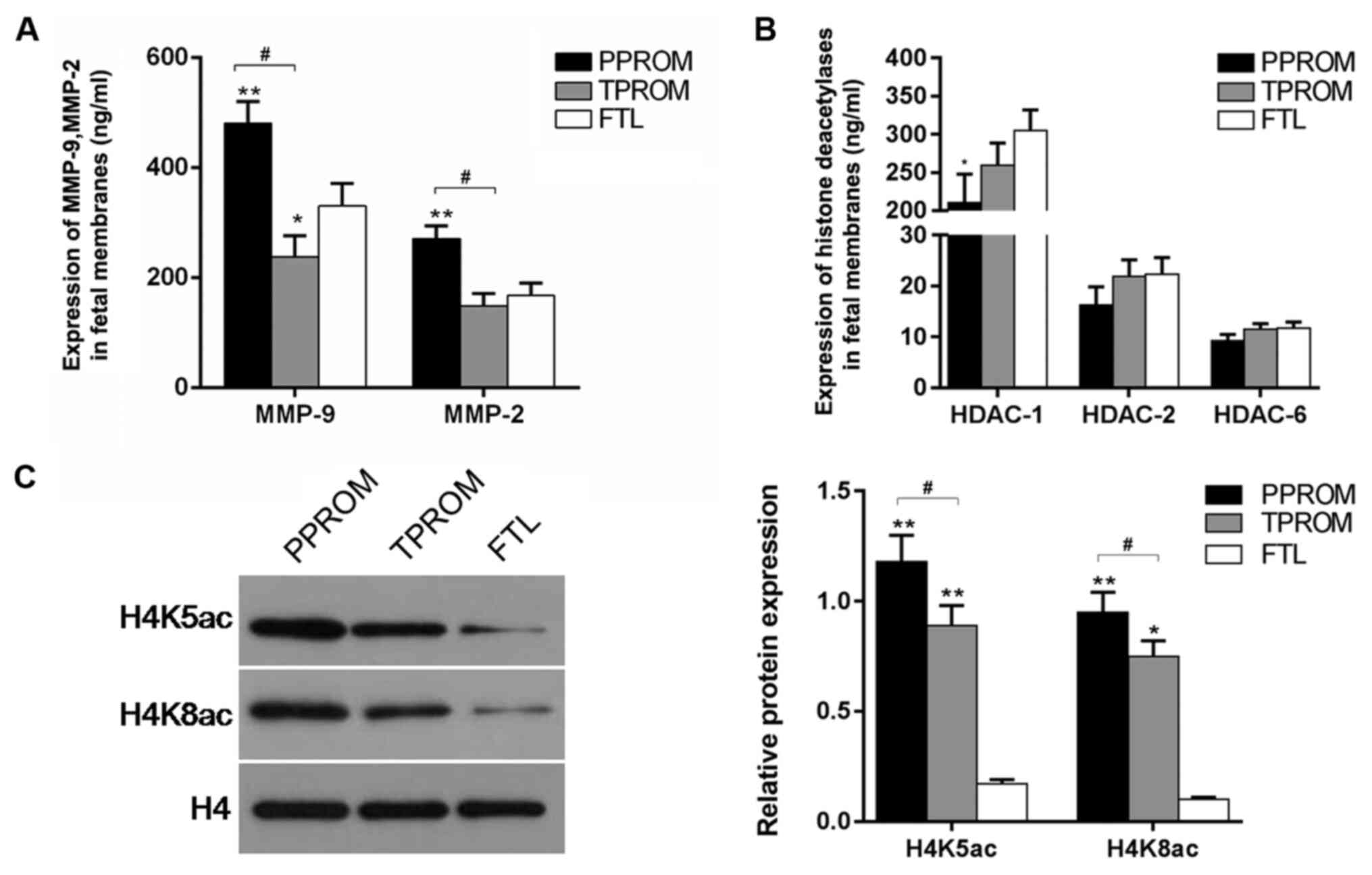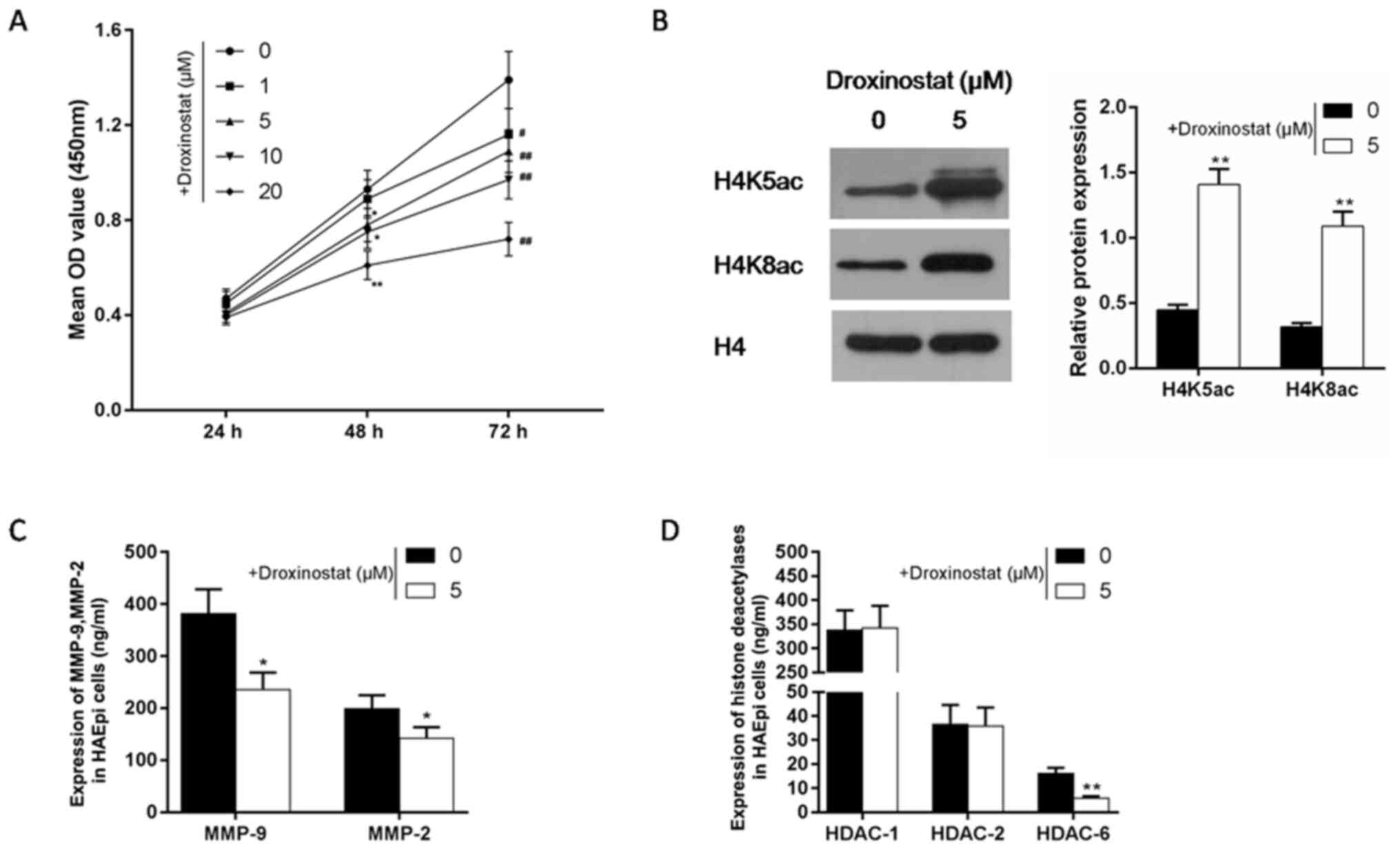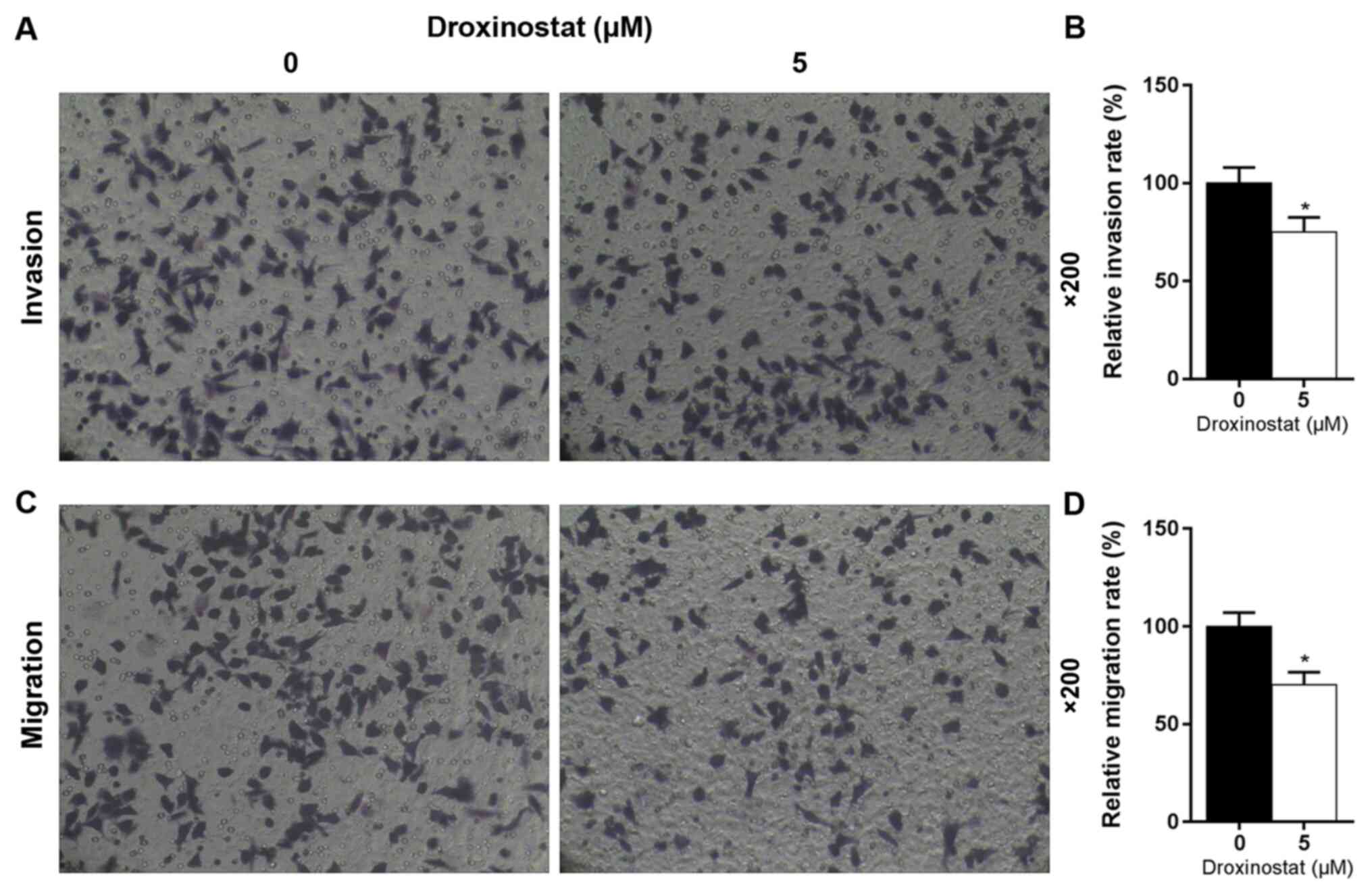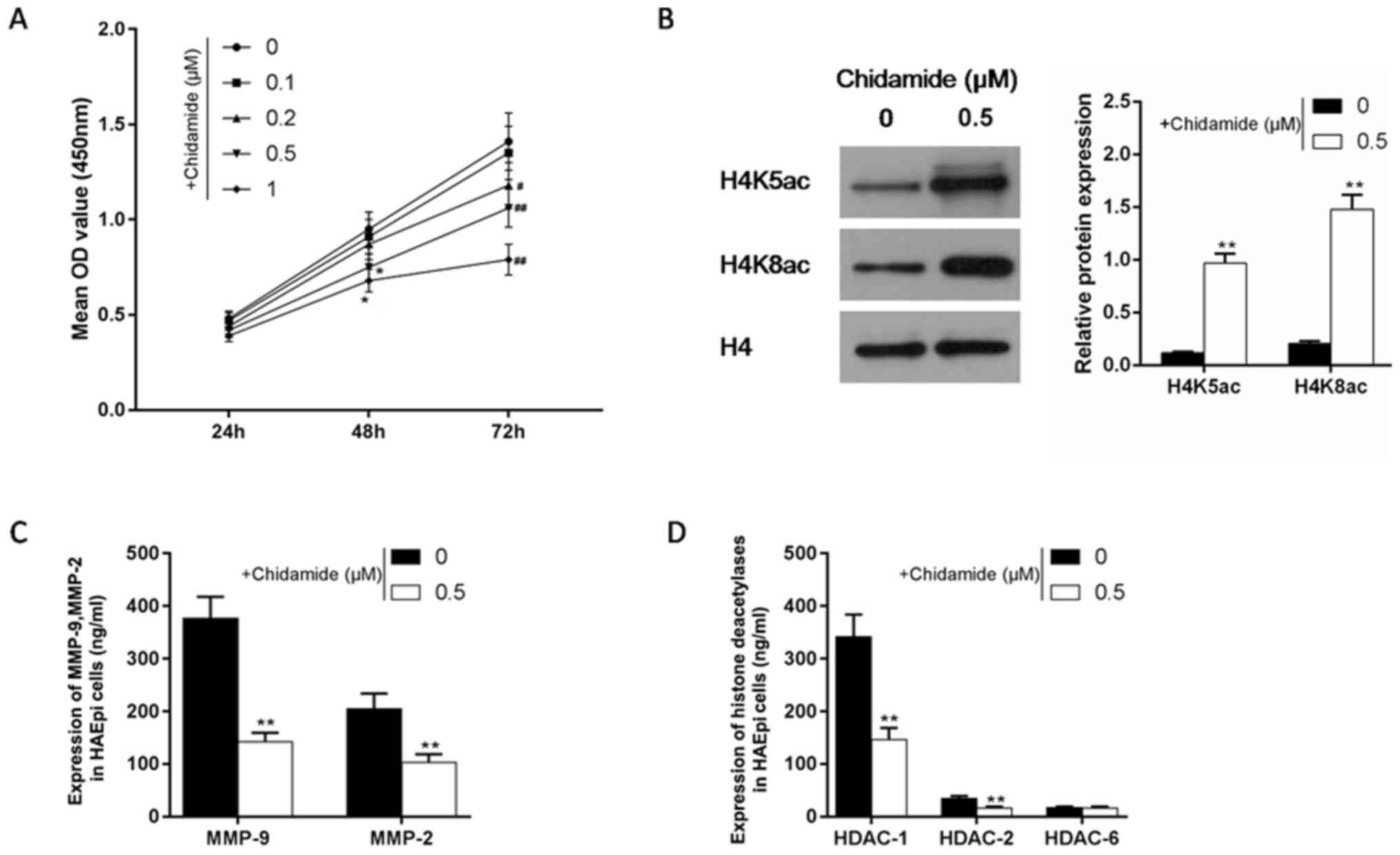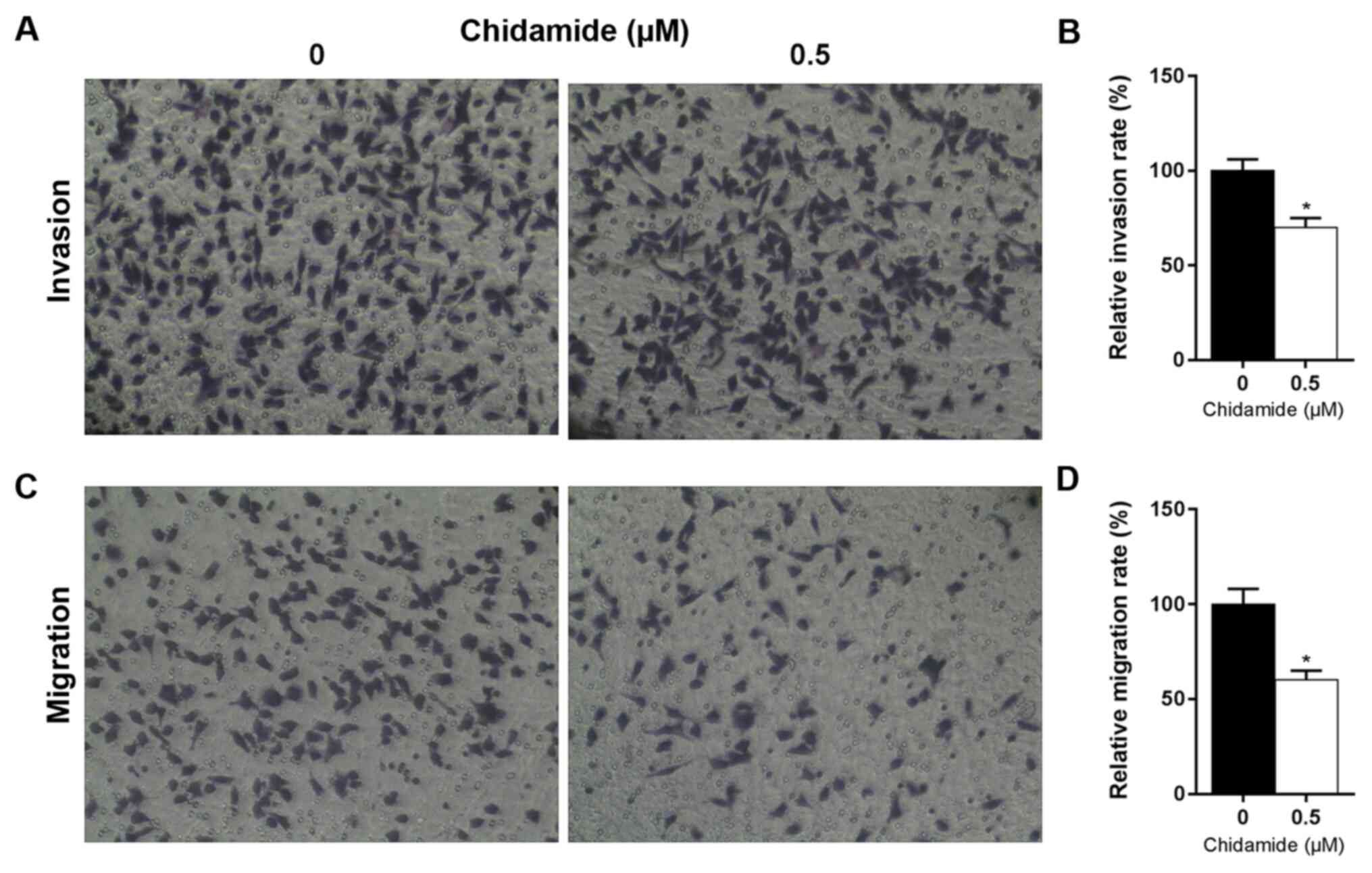|
1
|
Eleje GU, Adinma JI, Ghasi S, Ikechebelu
JI, Igwegbe AO, Okonkwo JE, Okafor CI, Ezeama CO, Ezebialu IU and
Ogbuagu CN: Antibiotic susceptibility pattern of genital tract
bacteria in pregnant women with preterm premature rupture of
membranes in a resource-limited setting. Int J Gynaecol Obstet.
127:10–14. 2014.PubMed/NCBI View Article : Google Scholar
|
|
2
|
Mercer BM: Preterm premature rupture of
the membranes. Obstet Gynecol. 101:178–193. 2003.PubMed/NCBI View Article : Google Scholar
|
|
3
|
Raines DA, Wagner A and Salinas A:
Intraamniotic infection and the term neonate. Neonatal Netw.
36:385–387. 2017.PubMed/NCBI View Article : Google Scholar
|
|
4
|
Wu T, Shi J, Bao S, Qu Y and Mu DZ: Effect
of premature rupture of membranes on maternal infections and
outcome of preterm infants. Zhongguo Dang Dai Er Ke Za Zhi.
19:861–865. 2017.PubMed/NCBI View Article : Google Scholar : (In Chinese).
|
|
5
|
Patriota AF, Guerra GV, de Melo BC, Santos
AC, Torres Junior AC and Souza AS: Amniotic fluid volume and
maternal outcomes in women with preterm premature rupture of
membranes. Rev Bras Ginecol Obstet. 36:146–151. 2014.PubMed/NCBI View Article : Google Scholar : (In Portuguese).
|
|
6
|
Romero R, Espinoza J, Goncalves LF, Gomez
R, Medina L, Silva M, Chaiworapongsa T, Yoon BH, Ghezzi F, Lee W,
et al: Fetal cardiac dysfunction in preterm premature rupture of
membranes. J Matern Fetal Neonatal Med. 16:146–157. 2004.PubMed/NCBI View Article : Google Scholar
|
|
7
|
Thomas W and Speer CP: Chorioamnionitis:
Important risk factor or innocent bystander for neonatal outcome?
Neonatology. 99:177–187. 2011.PubMed/NCBI View Article : Google Scholar
|
|
8
|
Biggio JR Jr, Ramsey PS, Cliver SP, Lyon
MD, Goldenberg RL and Wenstrom KD: Midtrimester amniotic fluid
matrix metalloproteinase-8 (MMP-8) levels above the 90th percentile
are a marker for subsequent preterm premature rupture of membranes.
Am J Obstet Gynecol. 192:109–113. 2005.PubMed/NCBI View Article : Google Scholar
|
|
9
|
Shaarawy M and El-Minawi AM: Prolactin and
calcitropic hormones in preterm premature rupture of membranes. Int
J Gynaecol Obstet. 84:200–207. 2004.PubMed/NCBI View Article : Google Scholar
|
|
10
|
Osaikhuwuomwan JA, Okpere EE, Okonkwo CA,
Ande AB and Idogun ES: Plasma vitamin C levels and risk of preterm
prelabour rupture of membranes. Arch Gynecol Obstet. 284:593–597.
2011.PubMed/NCBI View Article : Google Scholar
|
|
11
|
Bou-Resli MN, Al-Zaid NS and Ibrahim ME:
Full-term and prematurely ruptured fetal membranes. An
ultrastructural study. Cell Tissue Res. 220:263–278.
1981.PubMed/NCBI View Article : Google Scholar
|
|
12
|
Niknejad H, Yazdanpanah G and Kakavand M:
Extract of fetal membrane would inhibit thrombosis and hemolysis.
Med Hypotheses. 85:197–202. 2015.PubMed/NCBI View Article : Google Scholar
|
|
13
|
Mehats C, Schmitz T, Marcellin L and
Breuiller-Fouche M: Biochemistry of fetal membranes rupture.
Gynecol Obstet Fertil. 39:365–369. 2011.PubMed/NCBI View Article : Google Scholar : (In French).
|
|
14
|
Rodriguez Faba O, Palou-Redorta J,
Fernandez-Gomez JM, Algaba F, Eiró N, Villavicencio H and Vizoso
FJ: Matrix metalloproteinases and bladder cancer: What is new? ISRN
Urol. 2012(581539)2012.PubMed/NCBI View Article : Google Scholar
|
|
15
|
Choo QY, Ho PC, Tanaka Y and Lin HS:
Histone deacetylase inhibitors MS-275 and SAHA induced growth
arrest and suppressed lipopolysaccharide-stimulated NF-kappaB p65
nuclear accumulation in human rheumatoid arthritis synovial
fibroblastic E11 cells. Rheumatology (Oxford). 49:1447–1460.
2010.PubMed/NCBI View Article : Google Scholar
|
|
16
|
Bajracharya D, Shrestha B, Kamath A, Menon
A and Radhakrishnan R: Immunohistochemical correlation of matrix
metalloproteinase-2 and tissue inhibitors of metalloproteinase-2 in
tobacco associated epithelial dysplasia. Dis Markers.
2014(197813)2014.PubMed/NCBI View Article : Google Scholar
|
|
17
|
Fortunato SJ, Menon R and Lombardi SJ:
MMP/TIMP imbalance in amniotic fluid during PROM: An indirect
support for endogenous pathway to membrane rupture. J Perinat Med.
27:362–368. 1999.PubMed/NCBI View Article : Google Scholar
|
|
18
|
Fortunato SJ, Menon R, Ahmed NU, Bourgeois
M and Dildy GA: Amniotic fluid concentrations of collagenase-1 and
collagenase-3 are increased in polyhydramnios. J Perinat Med.
32:122–125. 2004.PubMed/NCBI View Article : Google Scholar
|
|
19
|
Park CW, Yoon BH, Park JS and Jun JK: A
fetal and an intra-amniotic inflammatory response is more severe in
preterm labor than in preterm PROM in the context of funisitis:
Unexpected observation in human gestations. PLoS One.
8(e62521)2013.PubMed/NCBI View Article : Google Scholar
|
|
20
|
Dubicke A, Akerud A, Sennstrom M, Hamad
RR, Bystrom B, Malmstrom A and Ekman-Ordeberg G: Different
secretion patterns of matrix metalloproteinases and IL-8 and effect
of corticotropin-releasing hormone in preterm and term cervical
fibroblasts. Mol Hum Reprod. 14:641–647. 2008.PubMed/NCBI View Article : Google Scholar
|
|
21
|
Sundar IK, Yao H and Rahman I: Oxidative
stress and chromatin remodeling in chronic obstructive pulmonary
disease and smoking-related diseases. Antioxid Redox Signal.
18:1956–1971. 2013.PubMed/NCBI View Article : Google Scholar
|
|
22
|
Legube G and Trouche D: Regulating histone
acetyltransferases and deacetylases. EMBO Rep. 4:944–947.
2003.PubMed/NCBI View Article : Google Scholar
|
|
23
|
Xiong C, Guan Y, Zhou X, Liu L, Zhuang MA,
Zhang W, Zhang Y, Masucci MV, Bayliss G, Zhao TC and Zhuang S:
Selective inhibition of class IIa histone deacetylases alleviates
renal fibrosis. FASEB J. 33:8249–8262. 2019.PubMed/NCBI View Article : Google Scholar
|
|
24
|
Vincent ZL, Mitchell MD and Ponnampalam
AP: Regulation of TIMP-1 in human placenta and fetal membranes by
lipopolysaccharide and demethylating agent 5-aza-2'-deoxycytidine.
Reprod Biol Endocrinol. 13(136)2015.PubMed/NCBI View Article : Google Scholar
|
|
25
|
Vadillo-Ortega F, Gonzalez-Avila G, Furth
EE, Lei H, Muschel RJ, Stetler-Stevenson WG and Strauss JF III:
92-kd type IV collagenase (matrix metalloproteinase-9) activity in
human amniochorion increases with labor. Am J Pathol. 146:148–156.
1995.PubMed/NCBI
|
|
26
|
Vadillo-Ortega F, Hernandez A,
Gonzalez-Avila G, Bermejo L, Iwata K and Strauss JF III: Increased
matrix metalloproteinase activity and reduced tissue inhibitor of
metalloproteinases-1 levels in amniotic fluids from pregnancies
complicated by premature rupture of membranes. Am J Obstet Gynecol.
174:1371–1376. 1996.PubMed/NCBI View Article : Google Scholar
|
|
27
|
Poljak M, Lim R, Barker G and Lappas M:
Class I to III histone deacetylases differentially regulate
inflammation-induced matrix metalloproteinase 9 expression in
primary amnion cells. Reprod Sci. 21:804–813. 2014.PubMed/NCBI View Article : Google Scholar
|
|
28
|
Practice bulletins No. 139. Premature
rupture of membranes. Obstet Gynecol. 122:918–930. 2013.PubMed/NCBI View Article : Google Scholar
|
|
29
|
Hua Y, Ding S, Zhang W, Zhou Q, Ye W, Chen
M and Zhu X: Expression of AQP3 protein in hAECs is regulated by
Camp-PKA-CREB signalling pathway. Front Biosci (Landmark Ed).
20:1047–1055. 2015.PubMed/NCBI View
Article : Google Scholar
|
|
30
|
Miki T, Lehmann T, Cai H, Stolz DB and
Strom SC: Stem cell characteristics of amniotic epithelial cells.
Stem Cells. 23:1549–1559. 2005.PubMed/NCBI View Article : Google Scholar
|
|
31
|
Zhu P, Liu Z, Zhou J and Chen Y: Tanshinol
inhibits the growth, migration and invasion of hepatocellular
carcinoma cells via regulating the PI3K-AKT signaling pathway. Onco
Targets Ther. 12:87–99. 2018.PubMed/NCBI View Article : Google Scholar
|
|
32
|
Witkin SS, Nasioudis D, Leizer J, Minis E,
Boester A and Forney LJ: Epigenetics and the vaginal microbiome:
Influence of the microbiota on the histone deacetylase level in
vaginal epithelial cells from pregnant women. Minerva Ginecol.
71:171–175. 2019.PubMed/NCBI View Article : Google Scholar
|
|
33
|
Saigal S and Doyle LW: An overview of
mortality and sequelae of preterm birth from infancy to adulthood.
Lancet. 371:261–269. 2008.PubMed/NCBI View Article : Google Scholar
|
|
34
|
Polimeni M and Prato M: Host matrix
metalloproteinases in cerebral malaria: New kids on the block
against blood-brain barrier integrity? Fluids Barriers CNS.
11(1)2014.PubMed/NCBI View Article : Google Scholar
|
|
35
|
Strauss JF III: Extracellular matrix
dynamics and fetal membrane rupture. Reprod Sci. 20:140–153.
2013.PubMed/NCBI View Article : Google Scholar
|
|
36
|
Romero R, Chaiworapongsa T, Espinoza J,
Gomez R, Yoon BH, Edwin S, Mazor M, Maymon E and Berry S: Fetal
plasma MMP-9 concentrations are elevated in preterm premature
rupture of the membranes. Am J Obstet Gynecol. 187:1125–1130.
2002.PubMed/NCBI View Article : Google Scholar
|
|
37
|
Yan H, Zhu L, Zhang Z, Li H, Li P, Wang Y
and Leng M: HMGB1-RAGE signaling pathway in pPROM. Taiwan J Obstet
Gynecol. 57:211–216. 2018.PubMed/NCBI View Article : Google Scholar
|
|
38
|
Mano Y, Shibata K, Sumigama S, Hayakawa H,
Ino K, Yamamoto E, Kajiyama H, Nawa A and Kikkawa F: Tocilizumab
inhibits interleukin-6-mediated matrix metalloproteinase-2 and -9
secretions from human amnion cells in preterm premature rupture of
membranes. Gynecol Obstet Invest. 68:145–153. 2009.PubMed/NCBI View Article : Google Scholar
|
|
39
|
Oner C, Schatz F, Kizilay G, Murk W,
Buchwalder LF, Kayisli UA, Arici A and Lockwood CJ:
Progestin-inflammatory cytokine interactions affect matrix
metalloproteinase-1 and -3 expression in term decidual cells:
Implications for treatment of chorioamnionitis-induced preterm
delivery. J Clin Endocrinol Metab. 93:252–259. 2008.PubMed/NCBI View Article : Google Scholar
|
|
40
|
Kumar D, Schatz F, Moore RM, Mercer BM,
Rangaswamy N, Mansour JM, Lockwood CJ and Moore JJ: The effects of
thrombin and cytokines upon the biomechanics and remodeling of
isolated amnion membrane, in vitro. Placenta. 32:206–213.
2011.PubMed/NCBI View Article : Google Scholar
|
|
41
|
Kwon JS, Kim YS, Cho AS, Cho HH, Kim JS,
Hong MH, Jeong HY, Kang WS, Hwang KK, Bae JW, et al: Regulation of
MMP/TIMP by HUVEC transplantation attenuates ventricular remodeling
in response to myocardial infarction. Life Sci. 101:15–26.
2014.PubMed/NCBI View Article : Google Scholar
|
|
42
|
Nishihara S, Someya A, Yonemoto H, Ota A,
Itoh S, Nagaoka I and Takeda S: Evaluation of the expression and
enzyme activity of matrix metalloproteinase-7 in fetal membranes
during premature rupture of membranes at term in humans. Reprod
Sci. 15:156–165. 2008.PubMed/NCBI View Article : Google Scholar
|
|
43
|
Franz MB, Poterauer M, Elhenicky M, Stary
S, Birner P, Vinatzer U, Husslein P, Streubel B and Husslein H:
Global and single gene DNA methylation in umbilical cord blood
cells after elective caesarean: A pilot study. Eur J Obstet Gynecol
Reprod Biol. 179:121–124. 2014.PubMed/NCBI View Article : Google Scholar
|
|
44
|
Wang F, Zhang N, Li B, Liu L, Ding L, Wang
Y, Zhu Y, Mo X and Cao Q: Heparin defends against the toxicity of
circulating histones in sepsis. Front Biosci (Landmark Ed).
20:1259–1270. 2015.PubMed/NCBI View
Article : Google Scholar
|
|
45
|
de Ruijter AJ, van Gennip AH, Caron HN,
Kemp S and van Kuilenburg AB: Histone deacetylases (HDACs):
Characterization of the classical HDAC family. Biochem J.
370:737–749. 2003.PubMed/NCBI View Article : Google Scholar
|
|
46
|
Gregoretti IV, Lee YM and Goodson HV:
Molecular evolution of the histone deacetylase family: Functional
implications of phylogenetic analysis. J Mol Biol. 338:17–31.
2004.PubMed/NCBI View Article : Google Scholar
|
|
47
|
Krusche CA, Vloet AJ, Classen-Linke I, von
Rango U, Beier HM and Alfer J: Class I histone deacetylase
expression in the human cyclic endometrium and endometrial
adenocarcinomas. Hum Reprod. 22:2956–2966. 2007.PubMed/NCBI View Article : Google Scholar
|
|
48
|
Huang Y, Yang W, Zeng H, Hu C, Zhang Y,
Ding N, Fan G, Shao L and Kuang B: Droxinostat sensitizes human
colon cancer cells to apoptotic cell death via induction of
oxidative stress. Cell Mol Biol Lett. 23(34)2018.PubMed/NCBI View Article : Google Scholar
|
|
49
|
Liu J, Li G, Wang X, Wang L, Zhao R, Wang
J, Kong Y, Ding J, Li J and Zhang L: Droxinostat, a histone
deacetylase inhibitor, induces apoptosis in hepatocellular
carcinoma cell lines via activation of the mitochondrial pathway
and downregulation of FLIP. Transl Oncol. 9:70–78. 2016.PubMed/NCBI View Article : Google Scholar
|
|
50
|
Xu Y, Zhang P and Liu Y: Chidamide
tablets: HDAC inhibition to treat lymphoma. Drugs Today (Barc ).
53:167–176. 2017.PubMed/NCBI View Article : Google Scholar
|
|
51
|
Gao S, Li X, Zang J, Xu W and Zhang Y:
Preclinical and clinical studies of chidamide (CS055/HBI-8000), an
orally available subtype-selective HDAC inhibitor for cancer
therapy. Anticancer Agents Med Chem. 17:802–812. 2017.PubMed/NCBI View Article : Google Scholar
|
|
52
|
Mann BS, Johnson JR, Cohen MH, Justice R
and Pazdur R: FDA approval summary: Vorinostat for treatment of
advanced primary cutaneous T-cell lymphoma. Oncologist.
12:1247–1252. 2007.PubMed/NCBI View Article : Google Scholar
|
|
53
|
Coiffier B, Pro B, Prince HM, Foss F,
Sokol L, Greenwood M, Caballero D, Borchmann P, Morschhauser F,
Wilhelm M, et al: Results from a pivotal, open-label, phase II
study of romidepsin in relapsed or refractory peripheral T-cell
lymphoma after prior systemic therapy. J Clin Oncol. 30:631–636.
2012.PubMed/NCBI View Article : Google Scholar
|
|
54
|
Wood TE, Dalili S, Simpson CD, Sukhai MA,
Hurren R, Anyiwe K, Mao X, Suarez Saiz F, Gronda M, Eberhard Y, et
al: Selective inhibition of histone deacetylases sensitizes
malignant cells to death receptor ligands. Mol Cancer Ther.
9:246–256. 2010.PubMed/NCBI View Article : Google Scholar
|
|
55
|
Lu X, Ning Z, Li Z, Cao H and Wang X:
Development of chidamide for peripheral T-cell lymphoma, the first
orphan drug approved in China. Intractable Rare Dis Res. 5:185–191.
2016.PubMed/NCBI View Article : Google Scholar
|















